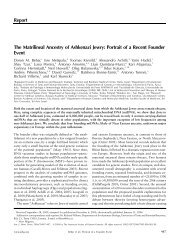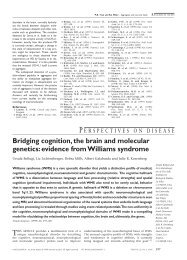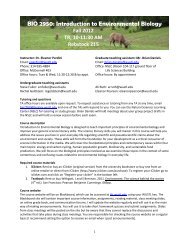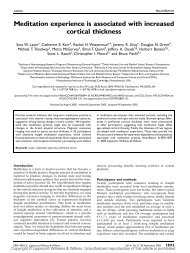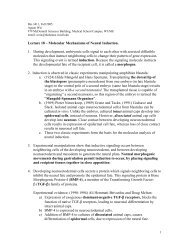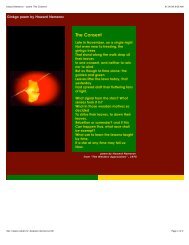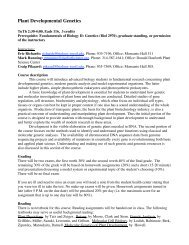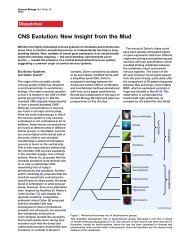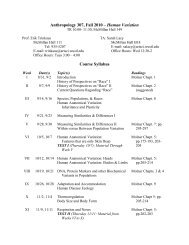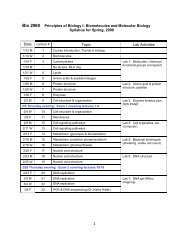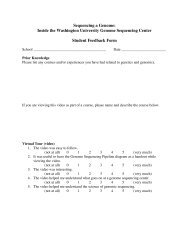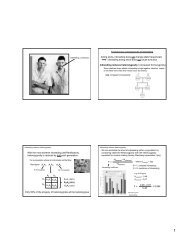Expression Cloning of noggin, a New Dorsalizing Factor Localized ...
Expression Cloning of noggin, a New Dorsalizing Factor Localized ...
Expression Cloning of noggin, a New Dorsalizing Factor Localized ...
Create successful ePaper yourself
Turn your PDF publications into a flip-book with our unique Google optimized e-Paper software.
‘r<br />
I I I I<br />
0 I IO 100<br />
Pg RNA<br />
Figure 3. Dorsal Axis Rescue <strong>of</strong> Ventraked Embryos by <strong>noggin</strong> and<br />
Xwnt-8 RNAs<br />
Xenopus embryos were ventralized by exposure to UV light approximately<br />
0.5 hr after fertilization. The embryos were then injected into<br />
one blastomere at the 4-cell stage with <strong>noggin</strong> RNA transcribed either<br />
from the full cDNA (A3) or from a plasmid containing a truncation in<br />
the 5’ untranslated region (<strong>noggin</strong>A5’). Other embryos were injected<br />
with Xwnt-8 RNA. The RNAs were injected at 1 to 100 pg in 10 nl <strong>of</strong><br />
water. Control embryos were injected with water only. Embryos were<br />
grown until untreated embryos<strong>of</strong> the same age reached approximately<br />
stage 41. The degree <strong>of</strong> dorsoanterior development was scored according<br />
to the scale <strong>of</strong> Kao and Elinson (1988). The mean DAIS for 12 to<br />
34 embryos at each RNA dose are plotted. Bars indicate the standard<br />
errors <strong>of</strong> the mean.<br />
<strong>noggin</strong>-Injected Blastomeres Act as a<br />
Nieuwkoop Center<br />
<strong>noggin</strong>, Xwnt-8, and writ-7 mRNAs all have the ability to<br />
restore dorsal axial development when injected into ventralized<br />
embryos (Smith and Harfand, 1991; Sokol et al.,<br />
1991; this study). We have shown previously that when<br />
Xwnf-8 mRNA is injected into one vegetal blastomere <strong>of</strong><br />
UV-treated embryos at the 32cell stage, dorsal structures<br />
are rescued (Smith and Harland, 1991). The descendants<br />
<strong>of</strong> the injected vegetal cells do not fate map to the rescued<br />
dorsal tissues, but rather to the endoderm. This result is<br />
consistent with earlier blastomere transplantation experiments<br />
in which the strongest source <strong>of</strong> the axis-inducing<br />
activity was found to be localized in dorsal vegetal cells<br />
(Gimlich and Gerhart, 1984; Gimlich, 1986; Kageura, 1990).<br />
Xwnt-8 mRNAcould also rescue dorsal development when<br />
injected into marginal zone cells (in which case they did<br />
contribute progeny to rescued dorsal tissues), but not<br />
when injected into animal pole cells.<br />
The effect <strong>of</strong> varying the site <strong>of</strong> <strong>noggin</strong> mRNA injection<br />
was investigated in a similar manner, and the results were<br />
similar to those observed for Xwnt-8. UV-treated embryos<br />
at the 32-cell stage were injected with either 0.5 ng <strong>of</strong><br />
p-galactosidase mRNA alone or 0.5 ng <strong>of</strong> f3-galactosidase<br />
mixed with 25 pg <strong>of</strong> <strong>noggin</strong>A5’ mRNA, as described previously<br />
(Smith and Harland, 1991). Injection <strong>of</strong> <strong>noggin</strong><br />
mRNA into blastomeres <strong>of</strong> the vegetal pole (tier 4 blastomeres)<br />
gave the most strongly dorsoanteriorized embryos<br />
(Figure 5). Representative embryos, stained with X-gal to<br />
indicate the fates <strong>of</strong> the injected cells, are shown in Figure<br />
6. In both <strong>of</strong> the vegetally injected embryos the nuclear<br />
X-gal staining was found almost exclusively in the endoderm<br />
(the mRNA encodes a 6-galactosidase that translocates<br />
to the nucleus, allowing distinction from the diffuse<br />
background stain). One <strong>of</strong> the embryos shown was<br />
strongly hyperdorsalized (DAI = -7) as a result <strong>of</strong> the<br />
<strong>noggin</strong> mRNA injection and has a severely truncated tail<br />
and enlarged head structures. Embryos were also rescued<br />
by <strong>noggin</strong> mRNA injections into the marginal zone (blastomeres<br />
from tiers 2 and 3) (Figure 5). In these embryos<br />
6-galactosidase staining was observed primarily in the<br />
axial and head mesoderm (Figure 6). As was observed<br />
previously with Xwnt-8, injection <strong>of</strong> <strong>noggin</strong> mRNA into the<br />
animal pole (tier 1 blastomeres) had very little effect on<br />
axis formation (Figures 5 and 6). Likewise, 6-galactosidase<br />
mRNA alone was without effect (Figure 5).<br />
<strong>noggin</strong> mRNA Is Expressed Both Maternally<br />
and Zygotically<br />
In Northern blot analysis <strong>of</strong> RNA from Xenopus embryos,<br />
two <strong>noggin</strong> mRNA species <strong>of</strong> approximate sizes 1.8 and<br />
1.4 kb were observed (Figure 7). Figure 7A shows the<br />
results <strong>of</strong> probing blots containing approximately 2 ug <strong>of</strong><br />
poly(A)’ RNA from the indicated stages with both <strong>noggin</strong><br />
and c-src probes (c-src serves as a control for RNA loading;<br />
Hemmati-Brivanlou et al., 1991). A relatively low level<br />
<strong>of</strong> <strong>noggin</strong> mRNA was detected in oocytes. By stage 11 the<br />
level <strong>of</strong> <strong>noggin</strong> mRNA was significantly higher, reflecting<br />
zygotic transcription (as opposed to the maternally<br />
deposited transcripts seen in oocytes). <strong>noggin</strong> mRNA remained<br />
at the elevated level up to the latest stage examined<br />
(stage 45).<br />
Based on previous results we expect the level <strong>of</strong> primary<br />
dorsalizing RNA in our library to be elevated in LiCI-treated<br />
embryos relative to normal or UV-treated embryos (Smith<br />
and Harland, 1991). Figure 78 shows the relative amount<br />
<strong>of</strong> <strong>noggin</strong> mRNA in total RNA samples from stage 8<br />
through 10 embryos that were either untreated, UV treated<br />
30 min after fertilization, or treated with LiCl at the 32-cell<br />
stage. Lithium ion treatment resulted in a large increase<br />
in the amount <strong>of</strong> <strong>noggin</strong> mRNA expressed, relative to untreated<br />
embryos. UV treatment had the opposite effect.<br />
<strong>noggin</strong> mRNA expression was essentially undetectable in<br />
total RNA samples from these embryos. Thus, the abundance<br />
<strong>of</strong> <strong>noggin</strong> mRNA in manipulated embryos parallels<br />
the rescuing activity.<br />
A simple model would predict that cytoplasm rotation<br />
results in localization <strong>of</strong> dorsalizing RNA on the prospective<br />
dorsal side <strong>of</strong> the embryo. We therefore analyzed the<br />
distribution <strong>of</strong> <strong>noggin</strong> mRNA in oocytes and cleavage<br />
stage embryos. Since the amount <strong>of</strong> maternally deposited<br />
<strong>noggin</strong> RNA is too low for in situ hybridization to detect<br />
above background, we used an RNAase protection assay.<br />
Oocytes were dissected into animal and vegetal halves.<br />
No enrichment <strong>of</strong> <strong>noggin</strong> mRNA was seen in either hemisphere<br />
relative to total oocyte RNA (Figure 8). Four-cell<br />
stage embryos were dissected into dorsal and ventral



